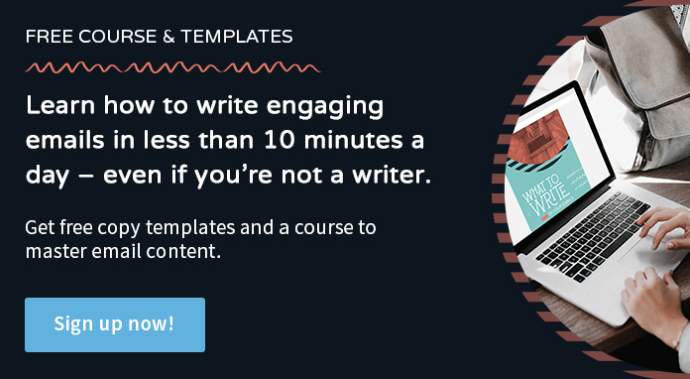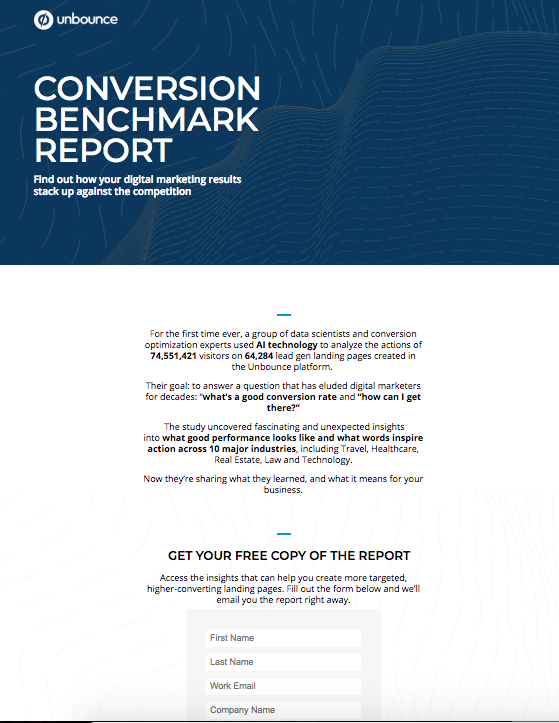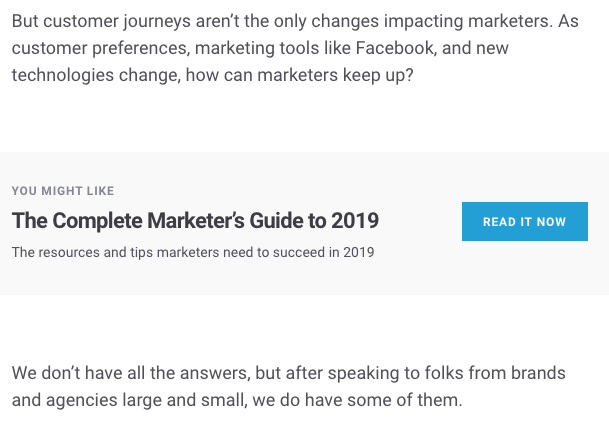5 Email List Growth Tactics
Canada’s anti-spam law and the EU’s General Data Protection Regulation (GDPR) put a lot of pressure on marketers. So much of what we do depends on our ability to grow our email lists.
While B2B companies can no longer ignore social media, give me a choice between a new follower and a new subscriber and I’ll pick the subscriber any day.
Email marketing is the king of the marketing kingdom with a 4,400% ROI and $44 for every $1 spent.
Source: Campaign Monitor
Here are five proven tactics to help you grow your email list year-round.
1. Offer a lead magnet… or don’t
Lead magnets are essentially “incentives” to convince your website visitors to give you their email address. They take many forms: eBooks, whitepapers, research reports, checklists, templates, self-assessments, mini-courses, resource lists, etc.
So, which one should you choose? It really depends on your persona, but it appears that B2B buyers are most willing to share their name and an email address in exchange for webinars (79 percent said they would share information), whitepapers (76 percent), eBooks (63 percent), case studies (57 percent) and third-party/analyst reports (66 percent). Meanwhile, they’re less willing to register for podcasts (19 percent), videos (19 percent) and infographics (24 percent).
Source: The 2017 Content Preferences Survey Report
Regardless of their format, high-converting lead magnets focus on value, meaning they contain precious information visitors may not easily find elsewhere. So, try to come up with something that would save them time and effort, or even better, save them money.
AWeber does this particularly well. Their “bribing offer” focuses on a specific desired outcome-writing engaging emails. In addition, the banner highlights a key benefit-you can do it in less than 10 minutes a day. The best lead magnets solve a specific problem right away.

The benefits of lead magnets have been so touted that you’d expect every decent B2B website to have at least half a dozen of them. The only problem is, they’re usually a lot of work.
But what if you could still get tons of subscribers WITHOUT a lead magnet?
A surprising experiment conducted by Borja Obeso showed that the “no-bribe offer” can perform much better than the lead magnet. In this case, the no-bribe offer was simply an image with an opt-in form that highlighted the benefits of joining their email list. The results? It generated 30 times more impressions and 53 times more conversions than the eBook offer.
Source: The Better than Ultimate Guide to Building Your Email List
Now, that does not necessarily mean that you should ditch lead magnets altogether. But in a world where consumers are growing tired of the latest marketing tricks, a little honesty may go a long way.
If you want your website visitors to join your email list, simply ask them and give them a compelling reason to. The results may surprise you.
2. Optimize your landing page
Assuming you want to use a lead magnet to grow your email list, the next thing you need is a great landing page, also called a squeeze page.
You can learn a lot about landing page best practices from Unbounce. We’re particularly fond of the landing page they created for their Conversion Benchmark report.

It has all the elements of a high-converting landing page:
- A clear headline (you know what you’re getting)
- A benefit-oriented sub-headline
- A great offer (you can’t find that report anywhere else)
- A visual representation of what’s inside the report
- A lead-capture form with a bright orange call-to-action button
- A call-to-action that matches the offer (download the report)
- Social proofs elements
To learn more, check out our article The Critical Elements of a High Converting Landing Page.
3. Use opt-in forms throughout your website
Creating a high-converting landing page requires real expertise, which is not always readily available, not to mention that certain companies use website templates that make it difficult or cost-prohibitive to create landing pages. The alternative? Opt-in forms.
The big advantage of opt-in forms is that you can add them pretty much anywhere. So, if you have already identified a few high-traffic pages on your websites, by all means, you should add a sign-up form on those pages.
Add opt-in forms to your high-traffic pages, keep them short and make sure they're optimized for mobile users #EmailMarketing #InboundMarketing Click To TweetThe placement of your opt-in form is very important. As a rule, it should always be placed above the fold, meaning the part of the screen visitors can see without scrolling.
If you run a successful blog, however, you may want to use in-line opt-ins, which are essentially opt-in boxes placed within content sections. Here is an example of what it looks like.

Whatever you decide, make sure to optimize your sign-up forms for mobile users in terms of size and button placement.
One of the most important decisions you’ll have to make is about the length of your sign-up forms. Short or long, which is best?
Knowing that the shorter the form, the higher the conversion, marketers generally prefer to use forms with as few fields as possible. But many salespeople view this as a missed opportunity to pre-qualify prospects, pressuring the marketing department to add more questions. Before you know it, your form has 12 fields, and nobody ever takes the time to fill it out.
To solve this dilemma, you may want to ask more questions in two steps. That’s what progressive profiling is all about.
Essentially, you make visitors believe they only need to enter their email address, but once they’ve hit the submit button, you direct them to a second form where they have to enter more information to complete the process.
The idea is that most people would rather finish what they’ve started than abandon halfway through.
That may be so, but we’re not big fans of multi-step opt-in forms at bNurture. For us, it is just another way to trick your visitors into doing something they had no intention of doing in the first place. In B2B, the buyer journey tends to be long and trust is paramount. So, in our opinion, if getting more conversions means losing a few points on the trust front, it may not be worth it.
That said, we’re not allergic to progressive profiling on the thank-you page. In this case, you would only ask for the email address on the first opt-in form, and once the person has clicked on the “Sign me up” button, you lead her to a thank-you form where she can enter more information.
This tends to work better if you make the additional fields optional and explain why this benefits the subscriber. For example, it’s perfectly OK to say something like “Please tell us more about yourself and your interests to help us improve our communications.”
4. Offline promotion
It’s not because you’re trying to convince people to opt-in that everything should happen online. In fact, we would argue this is one of the most overlooked opportunities to grow your email list.
Take the example of teleprospecting. Whether you work with an internal team or outsource this activity to cold calling pros, the chances that you call the right person at the right time are extremely low.
So, instead of just saying “I’ll call you back in a couple of months to check back with you,” you could offer to subscribe them to a lead nurturing program by simply saying “I understand there is no immediate opportunity right now, but would it be OK if I sent you occasional information about [topic]? Regardless of whom you decide to do business with, this could help you evaluate your options.”
Similarly, your salespeople could develop the habit of subscribing every prospect or suspect they engage with. Talk to your sales expert and get a sense of how many email subscribers they could bring in each week. Business lunches, events, new connections on LinkedIn… they all add up.
Ask your salespeople to help you grow your #EmailMarketing list Click To TweetSales pros tend to be very competitive and this is something you can leverage to your advantage. Believe it or not, but we’ve seen salespeople ready to kill for a $25 gift card contest.
Related: How Top Sellers Avoid Leaving Money on the Table
With Canada’s anti-spam legislation, however, you have to be extremely careful how you obtain consent, especially because implied consent, such as subscribing prospects who have verbally agreed to receive your newsletter, expires after two years. To avoid penalties, familiarize yourself with CASL and make sure to use email software that enables you to monitor tacit consent.
5. Pop-up forms
To be honest, this is our least favourite method of building an email list. Imagine inviting someone to your place and then slamming the door in her face. This is how pop-ups feel.
You would expect that with the rise of ad-blocking software and Google’s intent to penalize sites that are damaging the user experience, companies would slowly but surely abandon this annoying tactic. But it’s quite the opposite, and for a very simple reason: they work.
In fact, SumoMe-which is not entirely unbiased since the company sells welcome mats with an email collection field-did a study in which they analyzed two billion pop-up examples. It shows that the average conversion rate for pop-ups is 3.09%, and that in some rare cases, the conversion rate can be as high as 50%.
Source: SumoMe
Are pop-ups a guaranteed way to grow your email list? No. First, because not all pop-ups are created equal. They come in different shapes and sizes: full-screen pop-ups may be downright annoying, while slide-in boxes at the bottom corner of the page may feel less intrusive.
Second, context is key. This means taking into account the preferences of your target audience and timing the appearance of the pop-up form at an opportune moment.
We’re not convinced that if the pop-up is the first thing visitors see when they land on your website, it will significantly increase your conversion rate. In fact, SumoMe’s study confirmed that the highest-converting pop-ups don’t appear immediately. But if you offer visitors something of value such as an eBook once they’ve scrolled halfway down a page featuring an article on the same topic as the eBook, you’re more likely to increase your subscription rate.
There are also a few technical details you need to consider, such as the ability to exclude pop-up forms for mobile users, to avoid Google penalties.
Similarly, you don’t want to ruin the experience of your most loyal fans. Does the pop-up form allow you to exclude people already subscribed to your email list? Prompting first-time visitors to enter their email address is one thing, but annoying your regular blog readers every time they come back to read one of your articles is another.
Conclusion
Growing your email list takes time, but if you consider the value of email subscribers in the long run, it’s all worth it.
Don’t rely on just one tactic and remember that small actions repeated frequently can have a massive impact.
Experiment, measure your results and focus your efforts on the tactics that yield not just more email subscribers, but also the most qualified prospects.
What’s your favourite email growth tactic? Tell us why in the comments section.
Related Services
-
Email Newsletters
Create engaging newsletters that maintain a personal connection with your leads and contacts.
-
White Paper Writing Services
White papers are very effective lead generation tools, especially if your company sells complex products or services.
-
Social Media Strategy
Let us help you create a documented social media strategy that will bring clarity to your business, increase employee engagement and ultimately help you achieve your objectives faster.
